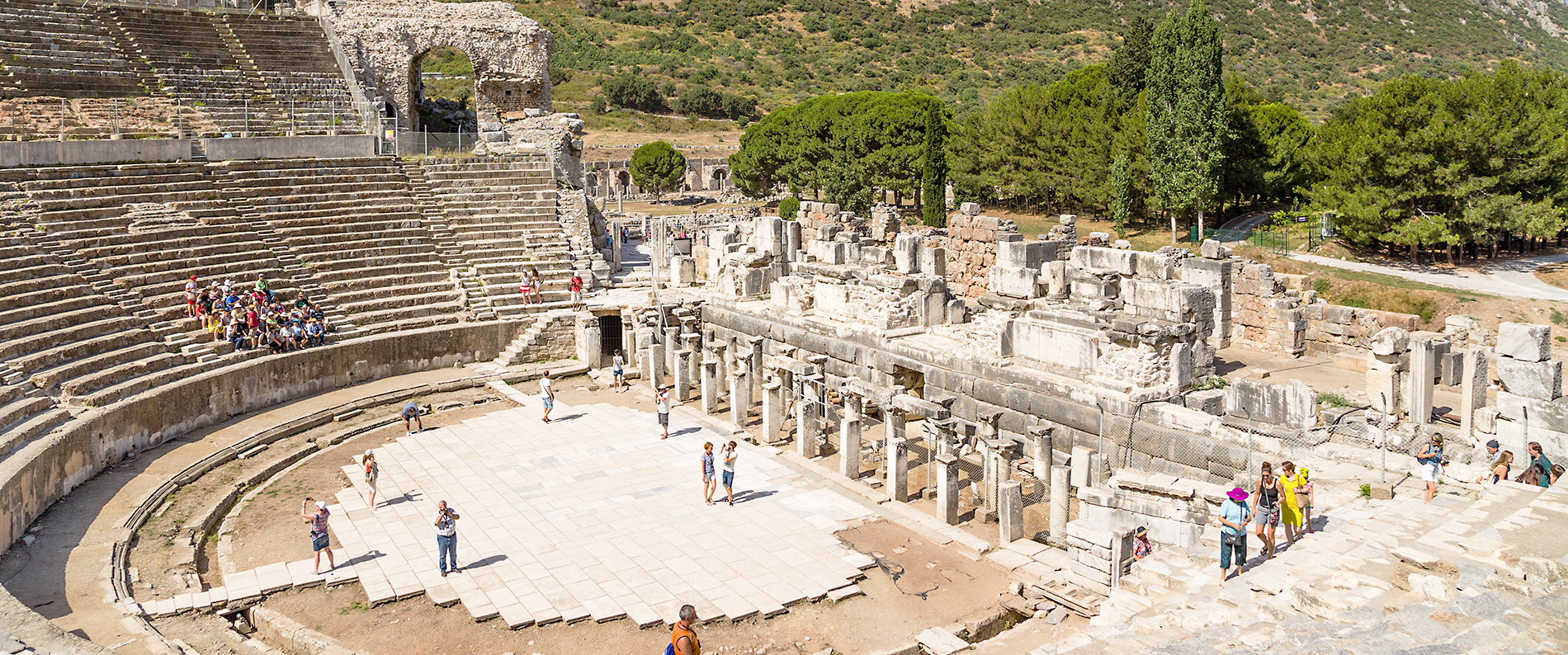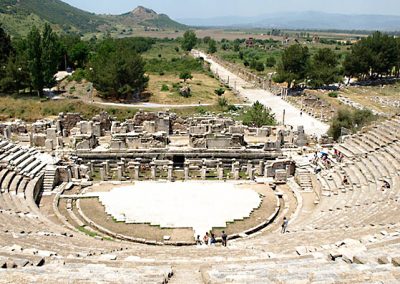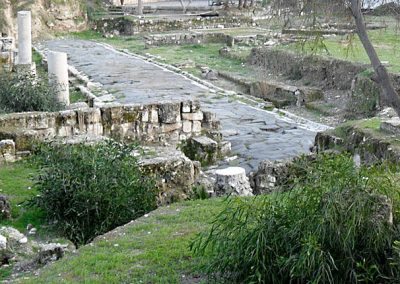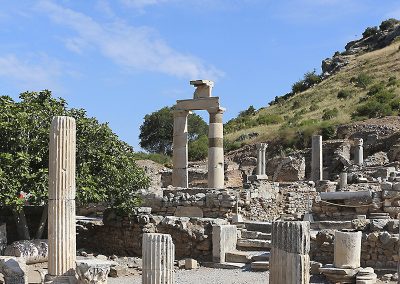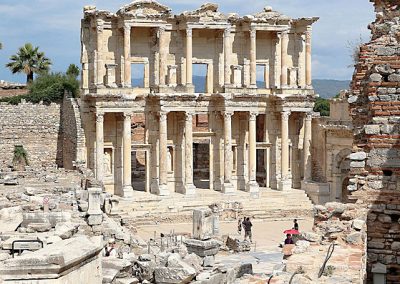
Bible, History, Archaeology
Bible,
History,
Archaeology
The apostle Paul in Ephesus
Contents:
The context of the riot – The riot – The temple of Artemis – Cistephore currency – Image gallery
The apostle Paul's missionary work in the city of Ephesus gave rise to events serious enough for Luke to record them in chapter 19 of his book of Acts.
The context of the riot
The Ephesians had recourse to soothsayers, priests and thaumaturges, as well as to talismans, which were sold around the temple of Artemis to all classes of society. Tiberius Claudius Balbillus, a famous and admired Roman knight in Ephesus at the time of Paul's stay, was both a high official and an astrologer who published several astrological writings entitled «Balbillea ephesia». This man was favored and befriended by Emperor Claudius, who made him a liaison officer between the Greek cities and the court, and the editor of the «Replies» (responsa) to their requests or questions. It is thought that this is what Paul was confronted with when he said in 2 Corinthians 1:9 «we regarded our death sentence as certain».». Balbillus had shown strong anti-Jewish feelings when, as head of worship and instruction in Alexandria, he had been the chief ambassador of the Alexandrians (in 41 AD) to complain about the Jews to the emperor.
 Image opposite: reconstruction of the Ephesian Temple of Artemis in Miniatürk Park, Istanbul © Zee Prime.
Image opposite: reconstruction of the Ephesian Temple of Artemis in Miniatürk Park, Istanbul © Zee Prime.
It was against this backdrop that Paul's preaching came under increasing protest, as it was seen as competition to the official religion. Certain craftsmen (notably the goldsmiths' guild, whose existence is attested in Ephesus), who made their living directly from the sanctuary and the great pilgrimages, also felt threatened by a decline in religious practice attributable to Paul; the same was true of the priests and all the guilds that made their living by subcontracting sacrifices. By manipulating the crowd, these guilds could send an accused person to torture or death by a vote of acclamation of the assembled population, without further ado. On an identical occasion - an imperial festival - the Jews of Alexandria were sent to the beasts in 38. So the danger was real for Paul.
A general view of the Ephesus theater today.
One of the largest theaters of antiquity, it could accommodate around 25,000 spectators who gathered there for theatrical presentations or feasts in honor of Artemis. During the Roman Empire, the theater was also used for gladiatorial combat. DR.
The riot
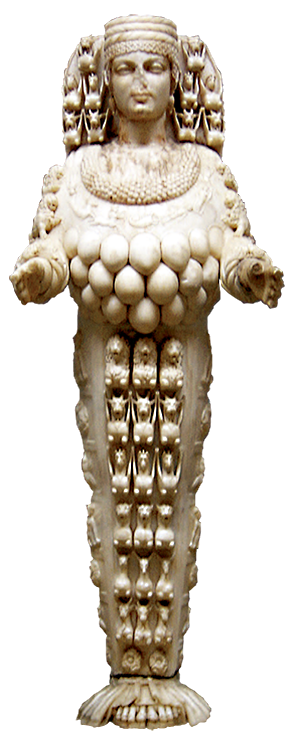
These words, favorably received, caused such a riot that the crowd gathered in the town theater to express their discontent.
The Scriptures tell us that on their way to the theater, they seized Paul's two traveling companions, Gaius and Aristarchus. Paul wanted to go to the assembly in front of this furious crowd, but his disciples prevented him. Luke tells us that the crowd was so excited that for almost two hours they shouted:
Great is the Artemis of Ephesus!
The movement was also tinged with anti-Semitism: during the riot, one of Paul's collaborators, Alexandre, was prevented from speaking as soon as the crowd recognized that he was a Jew.
Image opposite Asian Artemis was not the Artemis or Diana of classical mythology, but the mother goddess of Asia Minor, known as Cybele, Magna Mater and Ma.
It was a misshapen woman with a crowned head, innumerable breasts (according to other researchers, more like strings of bulls' testicles) and outstretched arms supported by props. Ephesus Archaeological Museum, Selçuk.
The city secretary intervened and somehow managed to calm the crowd. The secretary's speech used the usual arguments of Romanized provincial notables: the need to resort to the justice of the proconsuls for a trial and, above all, the risk of being accused of sedition for gathering without just cause. Indeed, in the context of Roman peace, ’order« was the watchword of Greek cities, and its maintenance was the objective of those in charge, who sought to gain the goodwill of those in power and obtain titles and dignities; at stake for Ephesus was the title of »guardian of the temple« (of the imperial cult).
Paul ministered as an apostle in the city for almost three years. He was thus able to lay the foundations of the most solid Christian church of the first century. His ministry was so effective that many of those who had been involved in magic made a heap of their books and burned them in public. (Acts 19:19).
The Church of Ephesus was one of the Seven Churches of Asia to which the letters of John's Apocalypse were addressed.. According to tradition, the apostle John spent the last years of his life in Ephesus after his exile on the island of Patmos.
The Church's third ecumenical council, held in this city in 431, defined the dogma of the person of Christ and his two natures, divine and human.
The temple of Artemis
Like other ancient cities, Ephesus was deeply religious. Above all, it worshipped Artemis, Asia's goddess of fertility. Three sanctuaries and two splendid temples were built on the same site in her honor. The first of these was begun around 550 B.C., inaugurated in 430, then burnt down by a certain Erostrate in 356. It took over thirty years to erect the second temple. When its construction was completed in 323 BC.., it was the most beautiful building ever erected in the Greek world, and was hailed as one of the Seven Wonders of the Ancient World.
Of Ionian order, it was four times larger than the Parthenon in Athens. It was approximately 104 metres long and 50 metres wide. It was supported by 100 columns, each of which was a marble monolith reaching 16 metres in height. Works by Phidias, Praxiteles, Scopas, Parrhasios and Apelles decorated the interior of this incomparable sanctuary.
The workings of Artemisia, a veritable priestly state staffed by countless eunuch priests and sacred courtesans, are well known. It accumulated immense wealth through donations and legacies. Its fame stemmed from the image of Diana it housed. This image was said to have descended from heaven (Acts 19:35).
The temple was burnt down by the Goths in 263 AD and then completely destroyed by the Christians.

Obverse:
Currency cistophore * (Pergamon).
Ephesus, circa 41-42.
Nude head with halo to the left.
Revers :
DIAN - EPHE.
Artemis of Ephesus standing in front of her temple; on the pediment, two statues and three tables. © D.R.
* The cistophore was originally a coin of Pergamum, named after the Dionysian cistus still depicted on the reverse. Because of its popularity, these coins were still minted even after the kingdom of Pergamon was bequeathed to Rome by the will of its last king, Attalus III, in 133 BC.
General view of the remains of the Ephesus theater where the Goldsmiths' Riot took place. It was capable of holding nearly 25,000 people. Carlos Delgado.
General view of the remains of the Ephesus theater where the Goldsmiths' Riot took place. It was capable of holding 25,000 people.
Remains of the ancient Roman road to Tarsus. © Nedim Ardoğa.
Remains of the ancient Roman road to Tarsus.
The Prytaneum in Ephesus. This building is the hearth and home of the city-state, home to the sacred fire that never goes out. © Bernard Gagnon.
The Prytaneum in Ephesus. This building is the hearth and home of the city-state, home to the sacred fire that never goes out.
The Roman Celsus Library in Ephesus. Built from 117 AD, it was dedicated by Tiberius Iulius Aquila Polemaenus, the city's governor, to Tiberius Iulius Celsus Polemaeanus, his father © Carlos Delgado.
The Roman library of Celsus in Ephesus. Built from 117 A.D., it was dedicated by Tiberius Iulius Aquila Polemaenus, the city's governor, to Tiberius Iulius Celsus Polemaeanus, his father.


